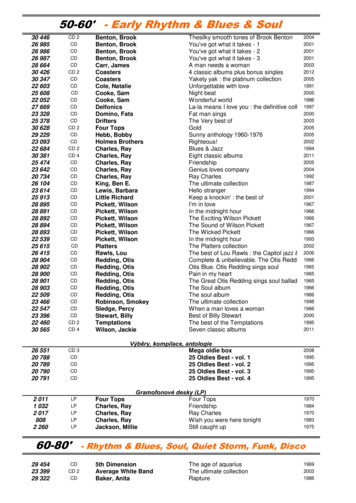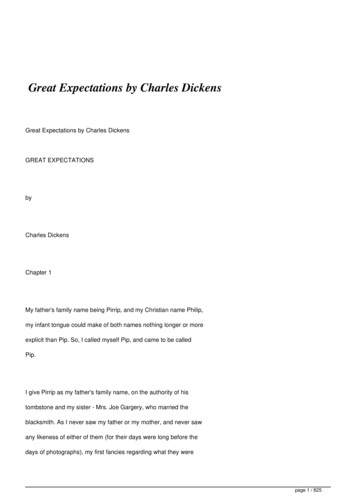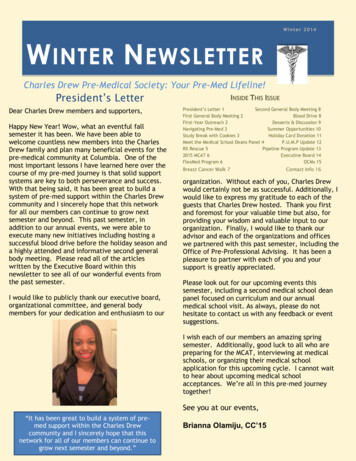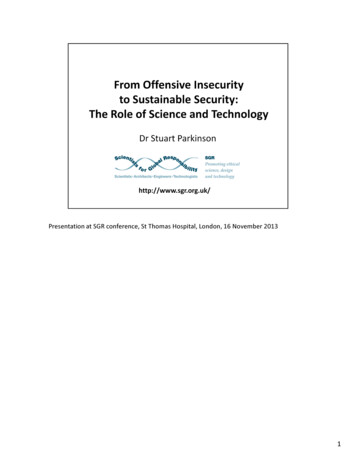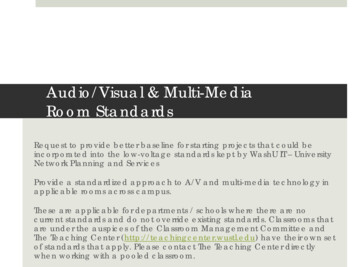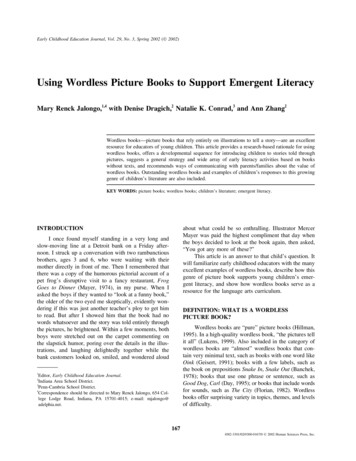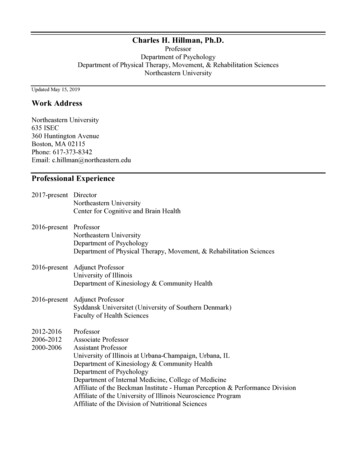
Transcription
Charles H. Hillman, Ph.D.ProfessorDepartment of PsychologyDepartment of Physical Therapy, Movement, & Rehabilitation SciencesNortheastern UniversityUpdated May 15, 2019Work AddressNortheastern University635 ISEC360 Huntington AvenueBoston, MA 02115Phone: 617-373-8342Email: c.hillman@northeastern.eduProfessional Experience2017-present DirectorNortheastern UniversityCenter for Cognitive and Brain Health2016-present ProfessorNortheastern UniversityDepartment of PsychologyDepartment of Physical Therapy, Movement, & Rehabilitation Sciences2016-present Adjunct ProfessorUniversity of IllinoisDepartment of Kinesiology & Community Health2016-present Adjunct ProfessorSyddansk Universitet (University of Southern Denmark)Faculty of Health ate ProfessorAssistant ProfessorUniversity of Illinois at Urbana-Champaign, Urbana, ILDepartment of Kinesiology & Community HealthDepartment of PsychologyDepartment of Internal Medicine, College of MedicineAffiliate of the Beckman Institute - Human Perception & Performance DivisionAffiliate of the University of Illinois Neuroscience ProgramAffiliate of the Division of Nutritional Sciences
Curriculum Vitae, CH HillmanPage 2Advisory Board Positions2018 –2016 –Scientific Advisory Board Member, Brain changes across the lifespan - the role of growthenvironments, self-regulation and physical activity (BRAIN), University of Jyväskylä,FinlandScientific Advisory Board Member, Research in Childhood Health, Syddansk Universitet(University of Southern Denmark)Education2000Doctor of PhilosophyDepartment of KinesiologyUniversity of Maryland at College Park, College Park, MD1997Master of ScienceDepartment of Exercise and Sport SciencesUniversity of Florida, Gainesville, FL1994Bachelor of ArtsUniversity of Miami, Coral Gables, 0072005-20081999-2000ScholarshipPublicationsEdited TextsElected to the National Academy of Kinesiology (Fellow #550)Applied Health Sciences Graduate Student Mentor AwardCollege of Agricultural, Consumer, & Environmental Sciences Team Award forExcellenceKing James McCristal Distinguished Scholar for the College of Applied Health Sciences27th Meiji Yasuda Life Foundation of Health and Welfare Research GrantOutstanding Research Award (Kamijo & Hillman)Society for Psychophysiological Research Student Poster Award (Eric Drollette)Applied Health Sciences Excellence in Guiding Undergraduate Research AwardUniversity of Illinois List of Teachers Ranked as Excellent by Their StudentsUniversity of Florida Outstanding Young AlumnusThe Institute for International Sport’s 100 Most Influential Sports EducatorsNational Institutes of Health, Loan Repayment Grant Program RecipientNational Institute of Mental Health, Ruth L. Kirschstein National Research ServiceAward for Individual Predoctoral Fellows (F31)
Curriculum Vitae, CH HillmanPage 31.Boecker, H., Hillman, C. H., Scheef, L., Strüder, H. K. (2012). Functional Neuroimaging inExercise and Sport Sciences. Springer Publishing Co: New York, NY: DOI: 10.1007/978-14614-3293-7Chapters in Texts1.Drollette, E. S. & Hillman, C. H. (in press). Cognitive and Academic Benefits for School AgeChildren. In T. Brusseau, S. Fairclough, & D. Lubans (Eds.), The Routledge Handbook of YouthPhysical Activity (pp. xx-xx). Routledge, Taylor & Francis Group: London & New York.2.Marques, A., Hillman, C. H., & Sardinha, L. B. (2018). Physical activity, cardiorespiratoryfitness and academic achievement. Health and Academic Achievement. InTechOpen, doi:10.5772/intechopen.712843.Hillman, C. H. & Castelli, D. M. (2017). Future directions: rigorous research design andauthentic application of neuroscience. In R. Meeusen, S. Schaefer, P. Tomporowski & R. Bailey(Eds.), Physical Activity and Educational Achievement: Insights from Exercise Neuroscience(pp. 63-74). Routledge, Taylor & Francis Group: London & New York.4.McAuley, E., Mullens, S., & Hillman, C.H. (2013). The relation of aerobic fitness to brainhealth and cognition across the human lifespan. In P.A. Hall (Ed.), Social Neuroscience andPublic Health: Foundations of an Emerging Discipline (pp. 235-252). Springer Publishing Co:New York, NY. DOI: 10.1007/978-1-4614-6852-3 145.Hillman, C. H. & Erickson, K. I. (2012). Cognition, Exercise. In F.-C. Mooren & J. S. Skinner(Eds.), The Encyclopedia of Exercise Medicine in Health and Disease. Springer-Verlag, LLC:New York, NY.6.Hillman, C. H., Kamijo, K., & Pontifex, M. B. (2012). Effects of Exercise on CognitiveProcessing Studied by ERPs in Children and Young Adults. In H. Boecker, C.H. Hillman, L.Scheef, H.K. Strüder (Eds.), Functional Neuroimaging in Exercise and Sport Sciences (pp. 419446). Springer: New York, NY. DOI: 10.1007/978-1-4614-3293-7 187.Castelli, D. M. & Hillman, C. H. (2012). Physical activity, cognition, and school performance:From neurons to neighborhoods. In A. Meyer & T. Gullotta (Eds.), Physical Activity Across theLifespan: Prevention and Treatment for Health and Well-Being (pp. 41-64). Springer, Inc: NewYork, NY.8.Hillman, C. H., Buck, S. M., & Themanson, J. T. (2009). Physical activity and neurocognitivefunction across the lifespan. In W. Chodzko-Zajko, A.F. Kramer, & L. Poon (Eds.), AgingExercise, and Cognition Series: Enhancing Cognitive Functioning and Brain Plasticity, VolumeIII (pp. 85-110). Human Kinetics: Champaign, IL.9.Hillman, C. H., Pontifex, M. B., & Themanson, J. T. (2009). Acute Aerobic Exercise Effects onEvent-Related Brain Potentials. In T. McMorris, M. Audiffren, & P. Tomporowski (Eds.),Exercise and Cognition (pp. 161-180). John Wiley and Sons, Inc: New York, NY.
Curriculum Vitae, CH HillmanPage 410.Kramer, A. F., & Hillman, C. H. (2006). Aging, physical activity, and neurocognitive function.In E. Acevado & P. Ekkekakis (Eds.), Psychobiology of Physical Activity (pp. 45-59). HumanKinetics: Champaign, IL.11.Janelle, C. M., & Hillman, C. H. (2003). Expert performance in sport: Current Perspectives andCritical Issues. In K.A. Ericsson & J. Starkes (Eds.), Recent Advances in Research on SportExpertise (pp. 19-47). Human Kinetics: Champaign, IL.12.Hatfield, B. D., & Hillman, C. H. (2001). The psychophysiology of sport: A mechanisticunderstanding of the psychology of superior performance. In R.N. Singer, H.A. Hausenblaus, &C.M. Janelle (Eds.), Handbook of Sport Psychology (pp. 362-386). John Wiley: New York, NY.National and Federal Committee Reports1.2018 Physical Activity Guidelines Advisory Committee. 2018 Physical Activity GuidelinesAdvisory Committee Scientific Report. Washington, DC: U.S. Department of Health and HumanServices, 2018.2.IOM (Institute of Medicine of the National Academy of Sciences) (2013). Educating the StudentBody: Taking Physical Activity and Physical Education to School. Washington, DC: TheNational Academies Press.Monographs1.Hillman, C. H. (2014). The relation of childhood physical activity to brain health, cognition, andscholastic achievement. Monographs of the Society for Research in Child Development, 79, 1189. (invited).Peer Reviewed Journal Articles (In print or accepted)1.Kao, S.-C., Cadenas-Sanchez, C., Shigeta, T. T., Walk, A. M., Chang, Y.-K., Pontifex, M. B., &Hillman, C. H. (in press). A systematic review of physical activity and cardiorespiratory fitnesson P3. Psychophysiology. (invited).2.Mora-Gonzalez, J., Esteban-Cornejo, I., Cadenas-Sanchez, C., Migueles, J. H., RodriguezAyllon, M., Molina-Garcia, P., Hillman, C. H., Catena, A., Pontifex, M. B., & Ortega, F. B. (inpress). Fitness, physical activity, working memory and neuroelectric activity in children withoverweight/obesity. Scandinavian Journal of Medicine & Science in Sports. doi:10.1111/sms.134563.Syväoja, H. J., Kankaanpää, A., Joensuu, L., Kallio, J., Hakonen, H., Hillman, C. H., &Tammelin, T. J. (in press). The longitudinal associations of fitness and motor skills withacademic achievement. Medicine & Science in Sports & Exercise. doi:10.1249/MSS.00000000000020314.Westfall, D. R., Logan, N. E., Khan, N. A., & Hillman, C. H. (in press). Cognitive assessmentsin hydration research involving children: methods and considerations. Annals of Nutrition &Metabolism. (invited).
Curriculum Vitae, CH HillmanPage 55.Szabo-Reed, A. N., Willis, E. A., Lee, J., Hillman, C. H., Washburn, R. A., & Donnelly, J. E.(in press). The influence of moderate-to-vigorous physical activity participation and time-on-taskon academic achievement in elementary-aged students. Translational Journal of the AmericanCollege of Sports Medicine.6.Pate, R. R., Hillman, C. H., Janz, K., Katzmarzyk, P. T., Powell, K. E., Torres, A., & WhittGlover, M. C. (2019). Physical Activity and Health in Children Under 6 Years of Age: ASystematic Review. Medicine & Science in Sports & Exercise, 51, 1282-1291. doi:10.1249/MSS.00000000000019407.Green, C. S., Bavelier, D., Kramer, A. F., Vinogradov, S., Ansorge, U., Ball, K. K., Bingel, U.,Chein, J. M., Colzato, L. S., Edwards, J. D., Facoetti, A., Gazzaley, A., Gathercole, S. E.,Ghisletta, P., Gori, S., Granic, I., Hillman, C. H., Hommel, B., Jaeggi, S. M., Kanske, P.,Karbach, J., Kingstone, A., Kliegel, M., Klingberg, T., Kühn, S., Levi, D. M., Mayer, R. E.,McLaughlin, A. C., McNamara, D. S., Morris, M. C., Nahum, M., Newcombe, N. S., Panizzutti,R., Prakash, R. S., Rizzo, A., Schubert, T., Seitz, A. R., Short, S. J., Singh, I., Slotta, J. D.,Strobach, T., Thomas, M. S. C., Tipton, E., Tong, X., Vlach, H. A., Wetherell, J. L., Wexler, A.,& Witt, C. M. (in press). Improving methodological standards in behavioral interventions forcognitive enhancement. Journal of Cognitive Enhancement, 3, Chojnacki, M. R., Holscher, H. D., Balbinot, A. R., Raine, L. B., Biggan, J. R., Walk, A. D. M.,Kramer, A. F., Cohen, N. J., Hillman, C. H., & Khan, N. A. (in press). Relations between modeof birth delivery and timing of developmental milestones and adiposity in preadolescence: aretrospective study. Early Human Development.9.Powell, K. E., King, A. C., Buchner, D. M., Campbell, W. W., DiPietro, L., Erickson, K. I.,Hillman, C. H., Jakicic, J. M., Janz, K. F., Katzmarzyk, P. T., Kraus, W. E., Macko, R. F.,Marquez, D. X., McTiernan, A., Pate, R. R., Pescatello, L. S., & Whitt-Glover, M. C. (in press).The scientific foundation for the 2018 physical activity guidelines for Americans. Journal ofPhysical Activity & Health. https://doi.org/10.1123/jpah.2018-061810.Leahy, A. A., Eather, N., Smith, J. J., Hillman, C. H., Morgan, P. J., Plotnikoff, R. C., Nilsson,M., Lonsdale, C., Costigan, S. A., Noetel, M., & Lubans, D. R. (in press). Feasibility andpreliminary efficacy of a teacher-facilitated high intensity interval training intervention for olderadolescents. Pediatric Exercise Science. https://doi.org/10.1123/pes.2018-003911.Pindus, D. M., Drollette, E. D., Raine, L. B., Kao, S.-C., Khan, N. A., Westfall, D. R., Hamill,M., Shorin, R., Calobrisi, E., John, D., Kramer, A. F., & Hillman, C. H. (in press). Moving fast,thinking fast: The relations of physical activity levels and bouts to neuroelectric indices ofinhibitory control in preadolescents. Journal of Sport and Health Science. (invited).12.Loui, P., Raine, L., Chaddock-Heyman, Kramer, A. F., & Hillman, C. H. (2019). Musicinstrument practice predicts white matter microstructure and cognitive abilities in childhood.Frontiers in Psychology. doi: 10.3389/fpsyg.2019.01198
Curriculum Vitae, CH HillmanPage 613.Leahy, A., Eather, N., Smith, J. J., Hillman, C. H., Morgan, P. J., Nilsson, M., Lonsdale, C.,Plotnikoff, R. C., Noetel, M., Halliday, E., Shigeta, T., Costigan, S., Walker, R., Young, S.,Valkenbergs, S., Harris, N., Gyawali, P., Kennedy, S., Lubans, D. R. (2019). A school-basedphysical activity intervention for older adolescents: Rationale and study protocol for the Burn 2Learn cluster randomised controlled trial. BMJ Open. doi:10.1136/bmjopen-2018-02602914.Erickson, K. I., Hillman, C. H., Stillman, C. M., Ballard, R. M., Bloodgood, B., Conroy, D. E.,Macko, R., Marquez, D. X., Petruzzello, S. J., & Powell, K. E. (2019). Physical activity,cognition, and brain outcomes: A review of the 2018 Physical Activity Guidelines. Medicine &Science in Sports & Exercise, 51, 1242-1251. doi: 10.1249/MSS.000000000000193615.Hoffman, J. A., Schmidt, E. M., Castaneda-Sceppa, C., John, D., & Hillman, C. H. (2019). Thetheoretical foundation, fidelity, feasibility, and acceptability of a teacher training to promotephysical activity among preschoolers in child care: a pilot study. Preventive Medicine Reports,13, 214-217. ejo, I., Mora-Gonzalez, J., Cadenas-Sanchez, C., Contreras-Rodriguez, O.,VerdejoRomán, J., Henriksson, P., Migueles, J. H., Rodriguez-Ayllon, M., Molina-García, P., Hillman,C. H., Kramer, A. F., Erickson, K. I., Catena, A., Verdejo-García, A., Ortega, F. B. (2019).Fitness, cortical thickness, and surface area in overweight/obese children: the mediating role ofbody composition and relationship with intelligence. Neuroimage, 186, 771-781.17.Esteban-Cornejo, I., Rodriguez-Ayllon, M., Verdejo-Roman, J., Cadenas-Sanchez, C., MoraGonzalez, J., Chaddock-Heyman, L., Raine, L. B., Stillman, C. M., Kramer, A. F., Erickson, K.I., Catena, A., Ortega, F. B., Hillman, C. H. (2019). Physical fitness, white matter volume andacademic performance in children: Findings from the ActiveBrains and FITKids2 projects.Frontiers in Psychology, 10, 208. doi: 10.3389/fpsyg.2019.0020818.Hammer, R., Paul, E. J., Hillman, C. H., Kramer, A. F., Cohen, N. J., & Barbey, A. K. (2019).Individual differences in analogical reasoning revealed by multivariate task-based functionalbrain imaging. Neuroimage, 184, 993-1004. .Moore, R. D., Sicard, V., Pindus, D. M., Raine, L. B., Drollette, E. S., Scudder, M. R., Decker,S., Ellemberg, D., & Hillman, C. H. (2019). A targeted neuropsychological examination ofchildren with a history of sport-related concussion. Brain Injury, 33, 40820.Chaddock-Heyman, L., Erickson, K. I., Kienzler, C., Drollette, E., Raine, L., Kao, S.-C.,Bensken, J., Weisshappel, R., Castelli, D. M., Hillman, C. H., Kramer, A. (2018). Physicalactivity increases white matter microstructure in children. Frontiers in 95021.Hassevoort, K. M., Lin, A. S., Khan, N. A., Hillman, C. H., & Cohen, N. J. (2018). Added sugarand dietary fiber consumption are associated with creativity in preadolescent children.Nutritional Neuroscience. doi: 10.1080/1028415X.2018.1558003
Curriculum Vitae, CH HillmanPage 722.Hillman, C. H., McAuley, E., Erickson, K. I., Liu-Ambrose, T., & Kramer, A. F. (2018). OnMindful and Mindless Physical Activity and Executive Function: A Response to Diamond andLing (2016). Developmental Cognitive Neuroscience. https://doi.org/10.1016/j.dcn.2018.01.00623.Gejl, A. K., Bugge, A., Ernst, M. T., Tarp, J., Hillman, C. H., Have, M., Froberg, K., &Andersen, L. B. (2018). The acute effects of short bouts of exercise on inhibitory control inadolescents. Mental Health & Physical Activity, 15, .Kao, S.-C., Drollette, E. S., Ritondale, J. P., Khan, N. A., & Hillman, C. H. (2018). The acuteeffects of high-intensity interval training and moderate-intensity continuous exercise ondeclarative memory and inhibitory control. Psychology of Sport & Exercise, 38, .01125.Sharp, P. B., Sutton, B. P., Paul, E. J., Sherepa, N., Hillman, C. H., Cohen, N. J., Kramer, A. F.,Prakash, R., Heller, W., Telzer, E. H., & Barbey, A. K. (2018). Mindfulness training inducesstructural connectome changes in insula networks. Scientific Reports, 8, a, M., Hillman, C. H., Dowd, K. P., Cirera, E., & Puig-Ribera, A. (2018).ActivPALTM determined sedentary behaviour, physical activity and academic achievement.Journal of Sports Sciences, 36, 2311-2316. doi: 10.1080/02640414.2018.145121227.Raine, L. B., Kao, S.-C., Pindus, D., Westfall, D. R., Shigeta, T. T., Logan, N., CadenasSanchez, C., Li, J., Drollette, E. S., Pontifex, M. B., Khan, N. A., Kramer, A. F., & Hillman, C.H. (2018). A largescale re-analysis of childhood fitness and inhibitory control. Journal ofCognitive Enhancement, 2, 170-192.28.Daugherty, A. N., Zwilling, C., Paul, E. J., Sherpa, N., Allen, C., Kramer, A. F., Hillman, C. H.,Cohen, N. J., & Barbey, A. K. (2018). Multi-modal fitness and cognitive training to enhancefluid intelligence. Intelligence, 66, 32-43. äoja, H. J., Kankaanpää, A., Kallio, J., Hakonen, H., Kulmala, J., Hillman, C. H., Pesonen,A.-K., Tammelin, T. H. (2018). The relation of physical activity, sedentary behaviors andacademic achievement are mediated by fitness and bedtime. Journal of Physical Activity andHealth, 15, 135-143. doi:10.1123/jpah.2017-013530.Felez-Nobrega, M., Foster, J. L., Puig-Ribera, A., & Hillman, C. H. (2018). Measuring workingmemory in the Spanish population: validation of a multiple shortened complex span task.Psychological Assessment, 30, 274-279. http://dx.doi.org/10.1037/pas000048431.Hassevoort, K. M., Khan, N. A., Hillman, C. H., Kramer, A. F., Cohen, N. J. (2018). Relationalmemory is associated with academic achievement in preadolescent children. Trends inNeuroscience and Education, 13, 8-16. , L. B., Drollette, E. S., Kao, S.-C., Westfall, D., Chaddock-Heymen, L., Kramer, A. F.,Khan, N. A., & Hillman, C. H. (2018). The associations between adiposity, cognitive function,
Curriculum Vitae, CH HillmanPage 8and achievement in children. Medicine & Science in Sports & Exercise, 50, 1868-1874. doi:10.1249/MSS.000000000000165033.Westfall, D. R., Gejl, A. K., Tarp, J., Wedderkopp, N., Kramer, A. F., Hillman, C. H., & Bugge,A. (2018). Associations between aerobic fitness and cognitive control in adolescents. Frontiersin Psychology. doi.org/10.3389/fpsyg.2018.0129834.Singh, A. S., Saliasi, E., van den Berg, V., Uijtdewilligen, L., de Groot, R. H. M., Jolles, J.,Andersen, L. B., Bailey, R., Chang, Y.-K., Diamond, A., Ericsson, I., Etnier, J., Fedewa, A. L.,Hillman, C. H., McMorris, T., Pesce, C., Puehse, U., Tomporowski, P. D., & Chinapaw, M. J.M. (2018). Effects of physical activity interventions on cognitive and academic performance inchildren and adolescents: A novel combination of a systematic review and recommendationsfrom an expert panel. British Journal of Sports Medicine. , I., Catena, A., Hillman, C. H., Kramer, A. F., Erickson, K. I., & Ortega, F. B.(2018). Commentary: At least eighty percent of brain grey matter is modifiable by physicalactivity: A review study. Frontiers in Human Neuroscience. doi: 10.3389/fnhum.2018.0019536.Raine, L. B., Biggan, J. R., Baym, C. L., Saliba, B. J., Cohen, N. J., & Hillman, C. H. (2018).Adolescent changes in aerobic fitness are related to changes in academic achievement. PediatricExercise Science, 30, 106-114. doi: 10.1123/pes.2015-022537.Saint, S. E., Renzi-Hammond, L. M., Khan, N. A., Hillman, C. H., Frick, J. E., & Hammond,Jr., B. R. (2018). Association between macular carotenoids and cognitive function inpreadolescent children. Nutrients, 10, 193. doi:10.3390/nu1002019338.Drollette, E. S., Pontifex, M. B., Raine, L. B., Scudder, M. S., Moore, R. D., Kao, S.-C.,Westfall, D. W., Wu, C.-T., Kamijo, K., Castelli, D. M., Khan, N. A., Kramer, A. F., & Hillman,C. H. (2018). Effects of the FITKids physical activity randomized controlled trial on conflictmonitoring in youth. Psychophysiology, 55, doi:10.1111/psyp.1301739.Bugge, A., Möller, S., Westfall, D. R., Tarp, J., Gejl, A. K., Wedderkopp, N., & Hillman, C. H.(2018). Associations between waist circumference, metabolic risk and executive function inadolescents: a cross-sectional mediation analysis. PLOS ONE. doi: pone-d-17-43355r240.Johnson, C. L., Schwarb, H., Horecka, K. M., McGarry, M. D., Hillman, C. H., Kramer, A. F.,Cohen, N. J., & Barbey, A. K. (2018). Double dissociation of structure-function relationshipsbetween memory and fluid intelligence observed with magnetic resonance elastography.Neuroimage, 171, 99-106.41.Kern, B. D., Graber, K. C., Shen, S., Hillman, C. H., & McLoughlin, G. M. (2018). Associationof school-based physical activity opportunities, socioeconomic status, and third grade reading.Journal of School Health, 88, 34-43. doi: 10.1111/josh.1258142.Chaddock-Heyman, L., Weng, T. B., Kienzler, C., Erickson, K. I., Voss, M. W., Drollette, E. S.,Raine, L. B., Kao, S.-C., Hillman, C. H., & Kramer, A. F. (2018). Scholastic performance andfunctional connectivity of brain networks in children. PLOS ONE.
Curriculum Vitae, CH HillmanPage 943.Chojnacki, M. R., Raine, L. B., Drollette, E. S., Scudder, M. R., Kramer, A. F., Hillman, C. H.,& Khan, N. A. (2018). The negative influence of adiposity extends to intraindividual variabilityin cognitive control among preadolescent children. Obesity, 26, 405-411. doi:10.1002/oby.2205344.Walk, A., Raine, L. B., Kramer, A. F., Cohen, N. J., Khan, N. A., & Hillman, C. H. (2017).Differential effects of carbohydrates on behavioral and neuroelectric indices of selectiveattention in preadolescent children. Frontiers in Human 61445.Ward, N., Paul, E. J., Watson, P. D., Cooke, G. E., Hillman, C. H., Cohen, N. J., Kramer, A. F.,& Barbey, A. K. (2017). Enhanced Learning through Multimodal Training: Evidence from aComprehensive Cognitive, Physical Fitness, and Neuroscience Intervention. Scientific Reports,7, 5808. doi:10.1038/s41598-017-06237-546.Walk, A. M., Khan, N. A., Barnett, S. M., Raine, L. B., Kramer, A. F., Cohen, N. J., Moulton, C.J., Renzi-Hammond, L. M., Hammond, B. R., & Hillman, C. H. (2017). From neuro-pigments toneural efficiency: the relationship between retinal carotenoids and behavioral and neuroelectricindices of cognitive control in childhood. International Journal of Psychophysiology, 118, 47.Raine, L. B., Khan, N. A., Drollette, E. S., Pontifex, M. B., Kramer, A. F., & Hillman, C. H.(2017). Obesity, visceral adipose tissue, and cognitive function in childhood. The Journal ofPediatrics, 187, 134-140. doi.org/10.1016/j.jpeds.2017.05.02348.Bugge, A., Moller, S., Tarp, J., Hillman, C. H., Lima, R. A., Gejl, A. K., & Wedderkopp, N.(2017). Influence of a two to six year physical education intervention on scholastic performance;The CHAMPS study-DK. Scandinavian Journal of Medicine and Science in Sports. doi:10.1111/sms.1290249.Marques, A., Santos, D. A., Hillman, C. H., Sardinha, L. B. (2017). How does academicachievement relate to cardiorespiratory fitness, self-reported physical activity and objectivelyreported physical activity: A systematic review in children and adolescents aged 6-18 years.British Journal of Sports Medicine. doi:10.1136/bjsports-2016-09736150.Donnelly, J. E., Hillman, C. H., Greene, J. L., Hansen, D. M., Gibson, C. A., Sullivan, D. K.,Poggio, J., Mayo, M. S., Lambourne, K., Szabo-Reed, A. N., Herrmann, S. D., Honas, J. J.,Scudder, M. S., Betts, J. L., Henley, K., Hunt, S. L., & Washburn, R. A. (2017). Physical activityand academic achievement across the curriculum: results from a 3-year cluster-randomized trial.Preventive Medicine, 99, 140-145. arb, H., Johnson, C. L., Daugherty, A. M., Hillman, C. H., Kramer, A. F., Cohen, N. J., &Barbey, A. K. (2017). Aerobic fitness, hippocampal viscoelasticity and relational memoryperformance. NeuroImage, 153, 179-188. .Barnett, S. M., Khan, N. A., Raine, L. B., Moulton, C., Cohen, N. J., Kramer, A. F., HammondJr., B. R., Renzi- Hammond, L., & Hillman, C. H. (2017). Macular pigment optical density is
Curriculum Vitae, CH HillmanPage 10positively associated with academic performance among preadolescent children. NutritionalNeuroscience, 1-9. doi: 10.1080/1028415X.2017.132997653.Hassevoort, K., Khazoum, S. E., Walker, J. A., McCorkle, S. M., Raine, L. B., Hammond, B. R.,Renzi-Hammond, L. M., Kramer, A. F., Khan, N. A., Hillman, C. H., & Cohen, N. J. (2017).Macular carotenoids, aerobic fitness, and central adiposity are differentially associated withhippocampal-dependent relational memory in preadolescent children. The Journal of Pediatrics,183, 108-114. ez-Nobrega, M., Hillman, C. H., Cirera-Viñolas, E., & Puig-Ribera, A. (2017). Theassociation of context-specific sitting time and physical activity intensity to working memorycapacity and academic achievement in young adults. European Journal of Public Health, 27,741-746. , A. N., Willis, E. A., Lee, J., Washburn, R. A., Hillman, C. H., & Donnelly, J. E.(2017). Impact of 3 years of classroom physical activity bouts on time-on-task behavior.Medicine & Science in Sports & Exercise, 49, 2343-2350.56.Talukdar, T., Nikolaidis, A., Zwilling, C., Paul, E. J., Hillman, C. H., Cohen, N. J., Kramer, A.F., & Barbey, A. K. (2017). Aerobic fitness explains individual differences in the functionalbrain connectome of healthy young adults. Cerebral Cortex, 1-10. doi: 10.1093/cercor/bhx23257.Fanning, J., Roberts, S., Hillman, C. H., Mullen, S. P., Ritterband, L., & McAuley, E. (2017). Asmartphone app-delivered randomized factorial trial targeting physical activity in adults. Journalof Behavioral Medicine, 40, 712-729. doi: 10.1007/s10865-017-9838-y58.Greenlee, T. A., Greene, D. R., Ward, N. J., Reeser, G. E., Allen, C. M., Baumgartner, N. W.,Cohen, N. J., Kramer, A. F., Hillman, C. H., & Barbey, A. K. (2017). Effectiveness of a 16week high-intensity cardio-resistance training (HICRT) program in adults. Journal of Strengthand Conditioning Research, 31, 2528-2541.59.Kao, S.-C., Westfall, D. R., Soneson, J., Gurd, B., & Hillman, C. H. (2017). Comparison of theacute effects of high-intensity interval training and continuous aerobic walking on inhibitorycontrol. Psychophysiology, 54, 1335-1345. doi: 10.1111/psyp.1288960.Kao, S.-C., Drollette, E. S., Scudder, M. R., Raine, L. B., Westfall, D. R., Pontifex, M. B., &Hillman, C. H. (2017). Aerobic fitness is associated with cognitive control strategy inpreadolescent children. Journal of Motor Behavior, 49, 150-162.61.Hillman, C. H., Erickson, K. I., & Hatfield, B. D. (2017). Run for your life! Childhood physicalactivity effects on brain and cognition. Kinesiology Review, 6, 12-21. (invited).62.Hillman, C. H. & Biggan, J. R. (2017). A Review of Childhood Physical Activity, Brain, andCognition: Perspectives on the Future. Pediatric Exercise Science, 29, 170-176. (invited). doi:10.1123/pes.2016-0125
Curriculum Vitae, CH HillmanPage 1163.Kao, S.-C., Westfall, D. R., Parks, A. C., Pontifex, M. B., & Hillman, C. H., (2017). Muscularand aerobic fitness, working memory, and academic achievement in children. Medicine &Science in Sports & Exercise, 49, 500-508.64.Westfall, D. R., Kao, S.-C., Scudder, M. R., Pontifex, M. B., Hillman, C. H. (2017). Theassociation of aerobic fitness on congruency sequence effects in preadolescent children. Brain &Cognition, 113, 85-92. ul, E. J., Larsen, R. J., Nikolaidis, A., Ward, N., Hillman, C. H., Cohen, N. J., Kramer, A. F.,& Barbey, A. K. (2016). Dissociable brain biomarkers of fluid intelligence. NeuroImage, 137,201-211.66.Olson, E. A., Mullen, S. P., Raine, L. B., Kramer, A. F., Hillman, C. H., & McAuley, E. (2016).Integrated social- and neuro-cognitive model of physical activity behavior in older adults withdiabetes. Annals of Behavioral Medicine. doi: 10.1007/s12160-016-9850-467.Niemiro, G., Raine, L. B., Khan, N. A., Emmons, R., Little, J., Kramer, A. F., Hillman, C. H., &De Lisio, M. (2016). Circulating progenitor cells are positively associated with cognitivefunction in overweight/obese children. Brain, Behavior, & Immunity, 57, 47-52.68.Costigan, S. A., Eather, N., Plotnikoff, R. C., Hillman, C. H., & Lubans, D. R. (2016). Highintensity interval training on cognitive and mental health in adolescents. Medicine & Science inSports & Exercise, 48, 1985-1993.69.Pindus, D. M., Drollette, E. S., Scudder, M. S., Khan, N. A., Raine, L. B., Sherar, L. B., Esliger,D., Kramer, A. F., & Hillman, C. H. (2016). Associations among moderate-to-vigorous physicalactivity, indices of cognitive control, and academic achievement in preadolescents. The Journalof Pediatrics, 173, 136-142. doi: udder, M. R., Drollette, E. S., Szabo-Reed, A. N., Lambourne, K., Fenton, C. I., Donnelly, J.E., & Hillman, C. H. (2016). Tracking the relationship between children’s aerobic fitness andcognitive control. Health Psychology, 35, 967-978.71.Lubans, D., Richards, J., Hillman, C. H., Faulkner, G., Beauchamp, M. R., Nilsson, M., Kelly,P., Smith, J. J., Raine, L., Biddle, S. J. (2016). Physical Activity for Cognitive and Mental Healthin Youth: A Systematic Review of Mechanisms. Pediatrics, 138, e20161642.72.Hassevoort, K., Hillman, C. H., Khan, N. A., & Cohen, N. J. (2016). Childhood markers ofhealth behavior relate to hippocampal health, memory, and academic performance. Mind, Brain,and Education, 10, 162-170. (Invited).73.Chaddock-Heyman, L., Erickson, K. I., Chappell, M., Kienzler, C., Johnson, C., Knecht, A.,Drollette, E., Raine, L. B., Scudder, M. R., Kao, S.-C., Hillman, C. H., & Kramer, A. F. (2016).Aerobic fitness is associated with greater hippocampal cerebral blood flood in children.Developmental Cognitive Neuroscience, 20, 52-58.74.Tarp, J., Domazet, S. L., Froberg, K., Hillman, C. H., Anderson, L. B., & Bugge, A. (2016).Effectiveness of a school-base
Northeastern University Updated May 15, 2019 Work Address Northeastern University 635 ISEC 360 Huntington Avenue Boston, MA 02115 Phone: 617-373-8342 Email: c.hillman@northeastern.edu Professional Experience 2017-present Director Northeastern University Center for Cognitive and Brain Health 2016-present Professor
![The Book of the Damned, by Charles Fort, [1919], at sacred .](/img/24/book-of-the-damned.jpg)
